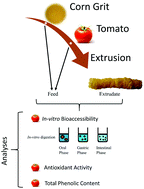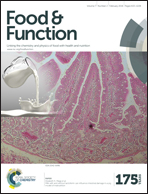The effect of extrusion on the functional components and in vitro lycopene bioaccessibility of tomato pulp added corn extrudates
Abstract
The effect of processing on functional ingredients and their in vitro bioaccessibility should be investigated to develop better food products. Tomato pulp was added as a functional ingredient to extrudates. The effects of extrusion on the functional properties of the extrudates and the in vitro bioaccessibility of lycopene were investigated. Two different temperature sets were applied during extrusion: 80 °C, 90 °C, 100 °C and 130 °C and 80 °C, 100 °C, 130 °C and 160 °C. Screw speed and feed rate were kept constant at 225 rpm and 36 ± 1 g min−1, respectively. The feed moisture content was adjusted to 30 ± 1% by mixing the tomato pulp to the corn grit. Antioxidant activity and the total phenolic content decreased after the extrusion process. High performance liquid chromatography (HPLC) analysis indicated that the lycopene content decreased after the extrusion process when feed and extrudates were compared. In vitro bioaccessibility of lycopene for the extruded samples with 160 °C last zone treatment temperature was higher than the feed and extruded samples with 130 °C last zone treatment temperature. The results indicate that extrusion affects the food matrix and the release of functional components.


 Please wait while we load your content...
Please wait while we load your content...